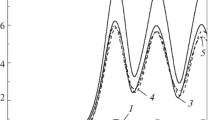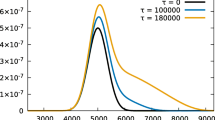Abstract
The possibility of using picosecond high-current relativistic electron beams for the formation of tubular rotating relativistic electron rings is investigated. Longitudinal compression of a tubular beam in a cusp is simulated numerically disregarding the space charge effects. The behavior of the characteristics of a compressed beam, which determines the tolerances in the initial parameters and magnetic system parameters, is investigated.
Similar content being viewed by others
References
G. A. Mesyats and M. I. Yalandin, Usp. Fiz. Nauk 175, 225 (2005) [Phys. Usp. 38, 567 (2005)].
K. D. Sinel’nikov, N. A. Khizhnyak, N. S. Repalov, et al., in Plasma Physics and Problems of Controlled Thermonuclear Fusion (Naukova Dumka, Kiev, 1965), Issue 4, pp. 388–403.
K. D. Sinel’nikov and B. S. Akshanov, in Plasma Physics and Problems of Controlled Thermonuclear Fusion (Naukova Dumka, Kiev, 1965), vol. 4, pp. 403–410.
N. C. Christofilos, in Proceedings of the 2nd United Nations International Conference on Peaceful Uses of Atomic Energy, Geneva, Switzerland, 1958, p. 279.
M. Friedman, Phys. Rev. Lett. 24, 1098 (1970).
R. E. Kribel, K. Shinsky, D. A. Felps, and H. H. Fleischmann, Plasma Phys. 16, 113 (1974) [Sov. J. Plasma Phys. 16, (1974)].
V. I. Veksler, in Proceedings of the CERN Symposium on High Energy Accelerators and Pion Physics, Geneve, 1956, Vol. 1, pp. 80–83; At. Energ. 2, 427 (1956).
V. P. Sarantsev and E. A. Perel’shtein, Collective Ion Acceleration by Electronic Rings (Atomizdat, Moscow, 1979) [in Russian].
G. L. Olson and U. Schumacher, Collective Ion Acceleration (Springer, Berlin, 1979).
M. L. Levin, A. L. Mints, Dokl. Akad. Nauk SSSR 204, 840 (1972) [Sov. Phys.Dokl. 17, 588 (1972)].
A. L. Mints, M. L. Levin, E. D. Naumenko, and T. N. Filimonova, Radiotekh. Elektron. (Moscow) 20, 2525 (1975).
W. W. Destler, D. W. Hudgings, R. A. Kehs, P. K. Misra, and M. J. Rhee, IEEE Trans. Nucl. Sci. 22, 995 (1975).
D. W. Hudgings, R. A. Meger, C. D. Striffler, et al., Phys. Rev. Lett. 40, 764 (1978).
C. D. Striffler, R. A. Meger, J. Grossmann, et al., IEEE Trans. Nucl. Sci. 26, 4234 (1979).
S. N. Dolya, A. K. Krasnykh, and V. V. Tikhomirov, Soobshch. Ob’edin. Inst. Yad. Issled., Dubna, No. R9-81-167 (1981).
A. G. Bonch-Osmolovskii and S. N. Dolya, Soobshch. Ob’edin. Inst. Yad. Issled., Dubna, No. R9-10-228 (1976).
J. H. Billen and L. M. Young, Los Alamos National Laboratory 2003, Rep. No. LA-UR-96-1834.
A. A. Amosov, Yu. A. Dubinsky, and N. V. Kopchenova, Computer Methods for Engineers (Vysshaya Shkola, Moscow, 1994) [in Russian].
Author information
Authors and Affiliations
Corresponding author
Additional information
Original Russian Text © N.S. Azaryan, S.A. Barengolts, S.N. Dolya, G.A. Mesyats, E.A. Perelstein, 2010, published in Zhurnal Tekhnicheskoĭ Fiziki, 2010, Vol. 80, No. 4, pp. 126–133.
Rights and permissions
About this article
Cite this article
Azaryan, N.S., Barengolts, S.A., Dolya, S.N. et al. Simulation of the formation of an electron ring by picosecond electron beams in a cusp-type magnetic system. Tech. Phys. 55, 557–564 (2010). https://doi.org/10.1134/S1063784210040213
Received:
Published:
Issue Date:
DOI: https://doi.org/10.1134/S1063784210040213




